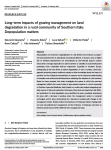Quaranta G., Salvia R., Salvati L., Paola V. De, Coluzzi R., Imbrenda V., Simoniello T. (2020). Long-term impacts of grazing management on land degradation in a rural community of Southern Italy: depopulation matters. Land Degradation & Development, 01/10/2020, vol. 31, n. 16, p. 2379-2394.
https://doi.org/10.1002/ldr.3583
https://doi.org/10.1002/ldr.3583
| Titre : | Long-term impacts of grazing management on land degradation in a rural community of Southern Italy: depopulation matters (2020) |
| Auteurs : | G. Quaranta ; R. Salvia ; L. Salvati ; V. De Paola ; R. Coluzzi ; V. Imbrenda ; T. Simoniello |
| Type de document : | Article |
| Dans : | Land Degradation & Development (vol. 31, n. 16, October 2020) |
| Article en page(s) : | p. 2379-2394 |
| Langues : | Anglais |
| Langues du résumé : | Anglais |
| Catégories : |
Catégories principales 07 - ENVIRONNEMENT ; 7.5 - Dégradation : Impact, DésertificationThésaurus IAMM PATURAGE ; DEGRADATION ; DEGRADATION DES TERRES ; EXODE RURAL ; PASTORALISME ; TERRE AGRICOLE ; GESTION DES RESSOURCES NATURELLES ; GESTION DU SOL ; SYSTEME AGROPASTORAL ; REGION MEDITERRANEENNE ; ITALIE |
| Résumé : | Depopulation and economic marginalization of rural districts have induced a progressive land abandonment in agricultural and pastoral districts. In Europe, areas at higher risk of farmland abandonment are characterized by low-intensity pasture systems whose fate is strongly dependent on state incentives or subsidies to rural development promoting more sustainable land-use trajectories. Especially in Southern Europe, undergrazing is the main driver of pasture degradation. In such a context, a land management preserving pasture resilience requires a wider knowledge about the impact of practices on the ecological characteristics of pastures and an improved understanding of complex socio-environmental interactions underlying the adoption of such practices. Based on these premises, this study investigates the extent to which the past land management reflects the current state of agro-pastoral systems in a local community of Southern Apennine (Basilicata, Italy). Based on a multi-scale analysis integrating multiple sources of data and exploratory techniques, three land-use trajectories with different implications for land degradation were identified: (a) areas completely abandoned, (b) areas with a decrease in grazing where the management system is remained unchanged, and (c) areas characterized by a decrease in grazing with changes in the management system. Results outline the importance of landscape history shaping (optimal and sub-optimal) land management and the influence of landscape structure on livestock performances within different farm management types. |
| Cote : | Réservé lecteur CIHEAM |
| URL / DOI : | https://doi.org/10.1002/ldr.3583 |







